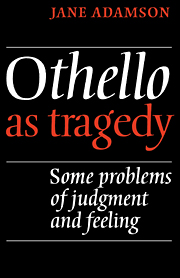Book contents
- Frontmatter
- Contents
- Preface
- Introduction
- 1 The ‘comforts’ of praise and blame
- 2 ‘Injuries’ and ‘remedies’: the first two acts
- 3 ‘Pluming up the will’: Iago's place in the play
- 4 Personal and professional identity: Othello in the first two acts
- 5 ‘Alacrity in hardness’: Othello's crisis in Acts III and IV
- 6 The ‘hollow hell’ of vengeance: Othello's attempted remedies
- 7 Self-charity and self-abnegation: the play's women in love
- 8 The ‘power to hurt’ and ‘be hurt’, ‘past all surgery’: the final scene
1 - The ‘comforts’ of praise and blame
Published online by Cambridge University Press: 16 September 2009
- Frontmatter
- Contents
- Preface
- Introduction
- 1 The ‘comforts’ of praise and blame
- 2 ‘Injuries’ and ‘remedies’: the first two acts
- 3 ‘Pluming up the will’: Iago's place in the play
- 4 Personal and professional identity: Othello in the first two acts
- 5 ‘Alacrity in hardness’: Othello's crisis in Acts III and IV
- 6 The ‘hollow hell’ of vengeance: Othello's attempted remedies
- 7 Self-charity and self-abnegation: the play's women in love
- 8 The ‘power to hurt’ and ‘be hurt’, ‘past all surgery’: the final scene
Summary
nothing extenuate,
Nor set down aught in malice.
(Othello, v, ii, 338–9)The crucial test of any view of Othello is its last scene, the culmination and climax of the whole drama. We have had to watch the hero vilify and strike his wife; we now have to watch while he kills her for a ‘sin’ we know she never committed, and then watch while he kills himself as well. At this point, the central critical questions become acute. What does the play eventually bring us to think and feel about Othello? How far, here and all through, are we brought to consider him as the victim, and how far the agent, of his fate? What bearing does our sense of these issues have on our estimate of the nature, scope and quality of the play as a whole? In relation to Shakespeare's other tragedies is Othello really a ‘comparatively simple’, ‘rather limited’ play, as we have so often been told?
On the first of these questions – what we are to make of Othello's behaviour, especially during the second half of the play – most people seem to have very fixed views. Generally speaking, they tend to take one of two positions about the play: to some, Shakespeare's main impulse is evidently to present the case for his hero; to others, it is evidently to present the case against him. On the one side, it is Othello's vulnerability that seems most important.
- Type
- Chapter
- Information
- Othello As TragedySome Problems of Judgement and Feeling, pp. 11 - 27Publisher: Cambridge University PressPrint publication year: 1980

